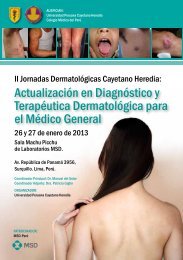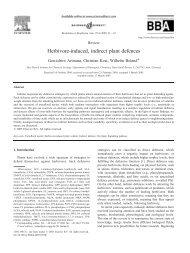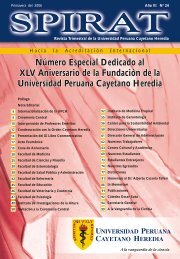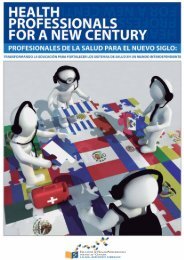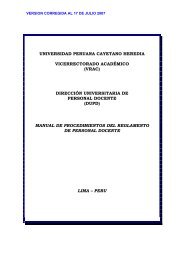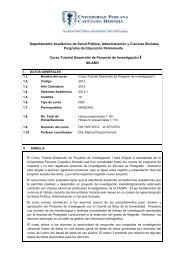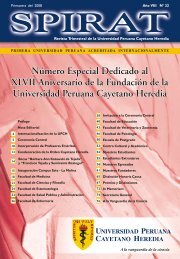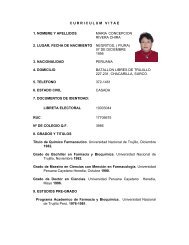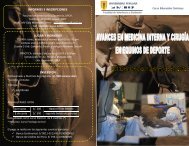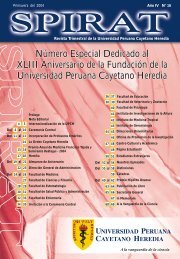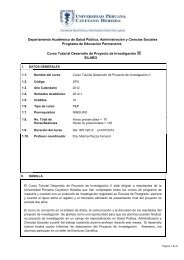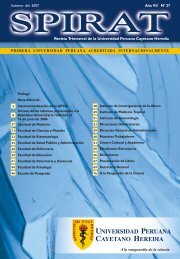1 TRAUMA AND HEALING: CROSS-CULTURAL AND ... - UPCH
1 TRAUMA AND HEALING: CROSS-CULTURAL AND ... - UPCH
1 TRAUMA AND HEALING: CROSS-CULTURAL AND ... - UPCH
Create successful ePaper yourself
Turn your PDF publications into a flip-book with our unique Google optimized e-Paper software.
task to keep the ‘memory’ of the parents’ trauma alive, and to take revenge on their behalf.Therapeutic interventions and ‘psycho-political dialogues’ are needed to break that cycle ofrevenge. This kind of preventive public health work is by necessity long-term work. Thequestion is also when to make a start with it. Setting up a ‘trauma program’ in besiegedSarajevo in 1994 for Doctors without Borders I tried to pay attention to such preventive workin the training program for counselors. It did not work. Most trainees, being involved in dayto-daysurvival and never having learned to reflect critically on one’s own history, were notready for it, yet. Only now, ten years later, I am told by some of them, the time is ripe for thiskind of work. That this critical reflection is necessary, also in therapeutic interventions, inorder to contain violence instead of reviving it, is illustrated by the following ethnographiccase study.Kidron (2003) studied the construction of trauma descendant identity in a supportgroup of descendants of Holocaust survivors experiencing previously unarticulated andunclassified psychosocial ills in daily life. The ratio of female-male participants was three toone. The participants in the group were led by the facilitator to construct a narrative in whichthe plot of their personal life stories was constituted by the distant past. The facilitator starteda session with a monologue informing the group of one specific psychosocial attribute ofsecond-generation identity, such as issues surrounding separation or intimacy. In such amonologue, the facilitator asked, for instance, ‘Are we allowing our children to separate fromus or are we afraid that separation is as traumatic for us as it was for our parents?’ (Kidron2003: 521). The scenarios presented at the start of each session functioned as a keymechanism in the descendant’s memory work, making him or her remember past separationorintimacy-related traumatic childhood events and causally explaining present crises byhistorical trauma. The discursive practices used in descendants’ narratives are ultimatelycarriers of memory, which both sustains and revitalizes historical grand narratives and thecultural scenarios they embed. The last issue raised for discussion in the final session is howone may transmit the burden of memory and testimony to the next generation because ‘wewant them to know and feel’ the burden (Kidron 2004: 531). Thus, the second generationHolocaust descendants turns its children into a third-generation descendants that will continueto carry the traumatic past.Kidron argues, similar to Argenti-Pillen above, that the potential of illness constructsas a collective mnemonic tool must be further explored. Future research may also exploregroup memory work as expanding its cultural horizon from tales of individual distress to talesof collective catastrophes and collective identities in the making. Considering theglobalization of Western trauma therapies based on the psychiatric PTSD concept to conflictriddenareas around the world, the questions raised by Kidron are pertinent. For her theconjunction of the person-centred psychological illness construct, with a collectivecommemorative agenda, raises perhaps the most interesting questions.The final issue that resulted from Kidron’s ethnographic study is whether culturespecificconcepts and healing practices from around the world have merged with importedPTSD therapies to allow for recovery and closure, or whether global trends in the politics ofremembering and forgetting have brought about an evolution of the concepts of healing,witnessing and survivorship to produce eternally wounded survivors of distant pasts, and, Iwould add, an accompanying eternal lust for revenge. Another side of the coin is that the12



